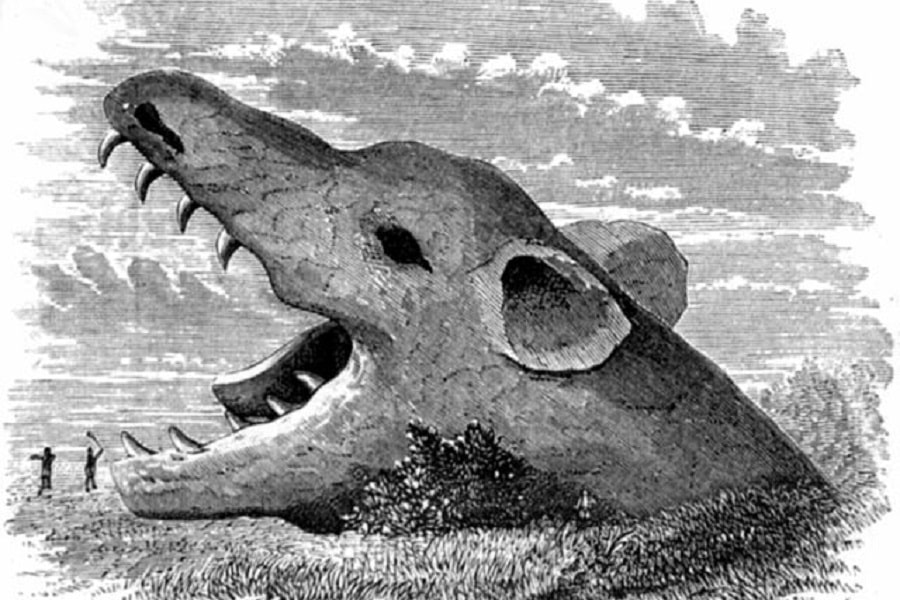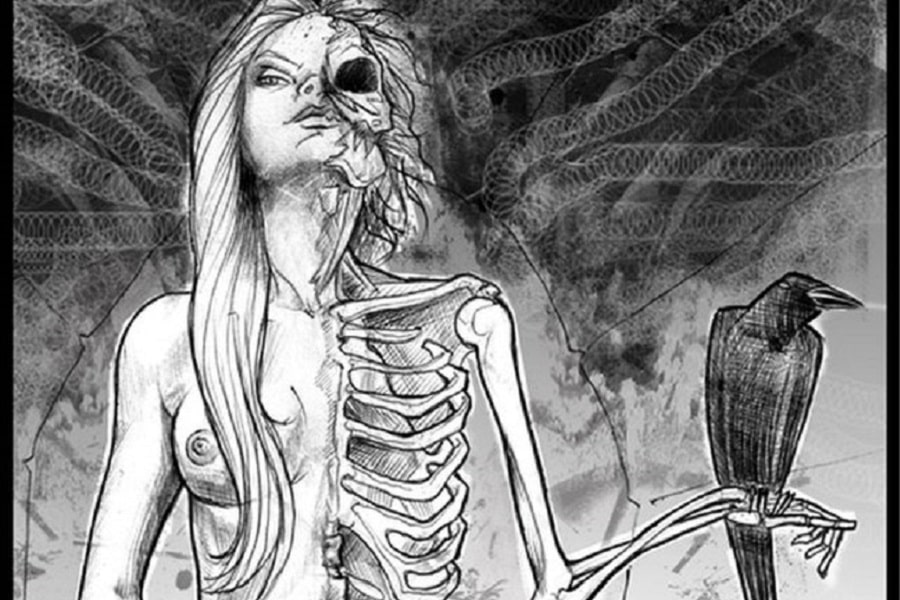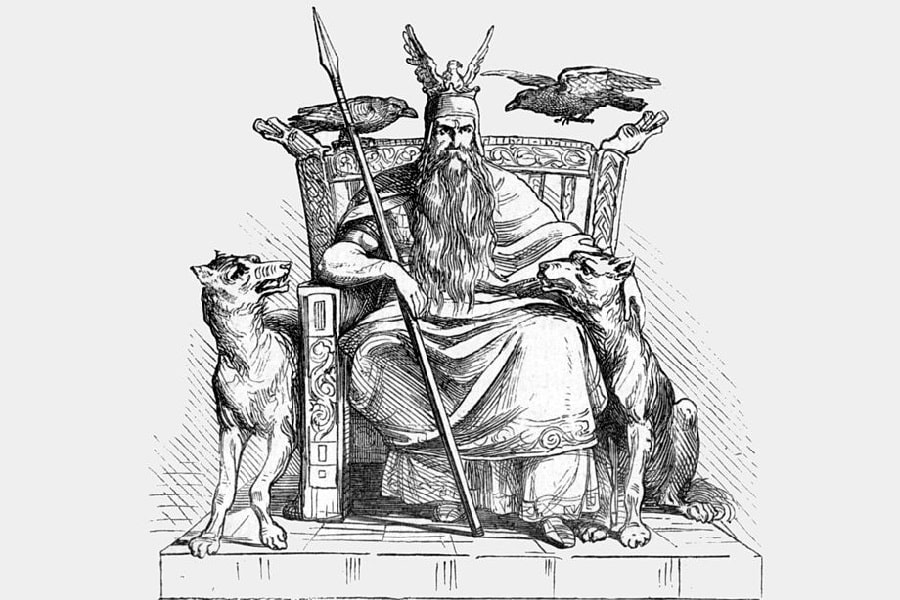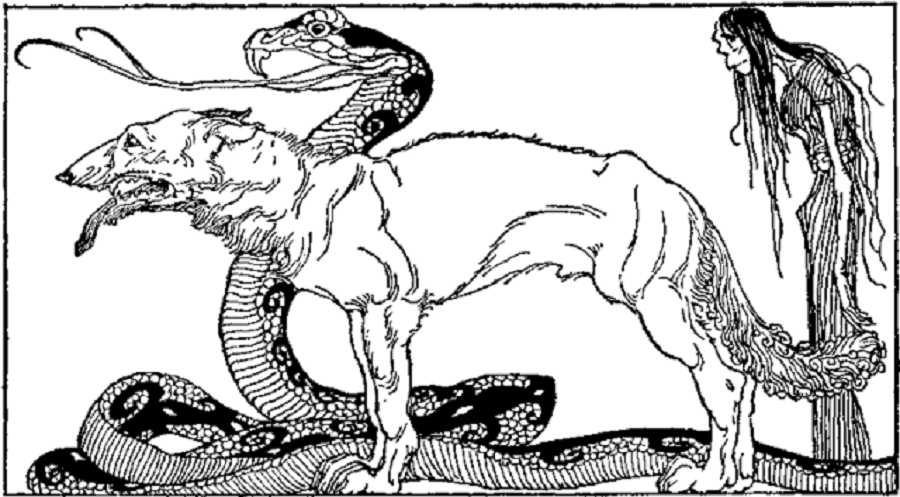The character of Angrboda is a lesser-known but complex figure in Norse mythology. Often associated with chaos and destruction, she has connections to three dangerous beings, but her character is more nuanced and richer than just her relationship with other gods, as it encompasses her powerful magical abilities, her prophetic knowledge, and her formidable presence as a giantess. Angrboda’s relationships with her children, the gods, and other characters in Norse mythology provide insight into the intricate web of alliances and feuds that make up the Norse pantheon. Through exploring her various connections and enduring legacy in mythology and popular culture, we gain a deeper understanding of the role she plays in this fascinating world.
Table of Contents
Who is Angroboda?

Angrboda is a figure from Norse mythology, specifically from the myths surrounding the god Loki. She was a giantess, which in Norse mythology refers to a type of powerful, often monstrous being that existed before the gods. Giantesses were typically associated with chaos and primal forces and were sometimes portrayed as antagonistic toward the gods.
Angrboda is particularly noteworthy because of her relationship with Loki. According to some versions of Norse mythology, she was one of Loki’s wives and the mother of his three monstrous children: Fenrir the wolf, Jormungandr the serpent, and Hel, the goddess of the underworld.
As the mother of such dangerous and powerful offspring, Angrboda herself is often portrayed as a formidable figure. She is said to have had great knowledge of magic and prophecy and was often associated with the idea of fate and destiny. She was said to possess great knowledge of the runes and was able to see into the future. Some stories even describe her as a shape-shifter, capable of transforming into various animals.
Angrboda’s name itself is also significant, as it means “she who brings grief” or “the one who brings sorrow.” This emphasizes her connection to darker forces and her association with fate and the inevitability of suffering.
Angrboda is a complex and fascinating character in Norse mythology, and her role as a giantess and mother of Loki’s children makes her an important figure in the mythology’s pantheon of powerful and dangerous beings.
Angrboda’s Family: Relationships with Her Children in Norse Mythology
Angrboda, also known as the “mother of monsters,” brought to life three of the most feared creatures in Norse mythology: Fenrir, Hel, and Jormungandr. Angrboda’s relationships with her children and their eventual roles in events such as Ragnarok, as well as their connections to other characters in Norse mythology such as Odin, Thor, and Loki, are significant aspects of her character and add to the richness and complexity of her role in the mythology. [1]
Fenrir: The Ferocious Wolf

Fenrir is perhaps the most well-known of Angrboda’s children. He is a giant wolf and is said to be the father of the wolves that will devour the sun and moon during Ragnarok [2]. Fenrir was born to Angrboda and the trickster god Loki.
Fenrir’s relationship with Angrboda is not explicitly described in Norse mythology, but it is believed that she raised him until he was old enough to join his father in Asgard. Fenrir’s fate is tragic, as he was prophesied to bring about the downfall of the Norse gods during Ragnarok.
Hel: The Ruler of the Underworld

Hel is another of Angrboda’s children, and she is often depicted as a goddess with a half-black, half-white body [2]. She is the ruler of Helheim, the underworld where the dead go after they die.
READ MORE: 10 Gods of Death and the Underworld From Around the World
Hel’s relationship with her mother is not as well-known as her relationship with her father, Loki. However, it is believed that Angrboda played a role in Hel’s upbringing, as she is the mother of the ruler of the underworld [5]. Hel’s domain is also closely connected to the world of the living, as she is responsible for deciding which souls go to Valhalla and which go to Helheim.
Jormungandr: The World Serpent

Jormungandr is the third and final child of Angrboda. He is a massive serpent who encircles the world, and his venom is said to be so deadly that it can kill even the gods.
Jormungandr’s relationship with Angrboda is not as well-documented as his relationships with his siblings. However, it is known that he was born to Angrboda and Loki, just like Fenrir. Jormungandr’s fate is also tied to Ragnarok, as he is prophesied to fight against Thor and ultimately be slain by him.
Angrboda’s children played significant roles in Norse mythology and continue to be influential figures in popular culture. Fenrir, Jormungandr, and Hel were all feared for their power and were central to important events such as Ragnarok. Angrboda’s role in bringing these creatures into the world and shaping their destinies adds to her significance as a character in Norse mythology. Although details about her relationships with her children are not well-documented, her status as their mother and her connections to other characters in Norse mythology demonstrate the complexity and richness of this ancient mythology. Additionally, the enduring popularity of Angrboda and her monstrous offspring in modern culture attests to their continuing relevance and impact.
Angrboda and the Conflicts with the Gods in Norse Mythology
Angrboda was not only the mother of three powerful children but also had a complicated relationship with the gods of Norse mythology. As a giantess, Angrboda was an outsider to the world of the gods and often found herself at odds with them.
Angrboda’s Relationship with Loki
Loki, a god known for his mischievous and unpredictable nature, had a close relationship with Angrboda and fathered all three of her children. Their bond was a source of both comfort and conflict [1]. On one hand, Loki loved Angrboda and their children deeply. On the other hand, his loyalty to the gods was always questionable, and his relationship with Angrboda and their children ultimately contributed to his downfall.

The Conflict between Angrboda and Odin
Angrboda’s relationship with the gods was not limited to Loki, however. Odin, the All-Father, saw Angrboda as a threat and ordered her capture. He sent his son Thor to bring her to Asgard, the realm of the gods. Thor succeeded in capturing Angrboda, but she was able to strike a deal with the gods.
In exchange for her freedom, Angrboda agreed to give up her children to the gods. The gods saw Fenrir, Hel, and Jormungandr as dangerous creatures and feared their power. Odin, in particular, was afraid that Fenrir would one day bring about the end of the world during Ragnarok [5].

Angrboda’s Role in the Ragnarok Myth
Angrboda’s willingness to give up her children highlights the complicated nature of her relationship with the gods. She loved her children fiercely but recognized that they posed a threat to the gods’ power and feared for their safety [2]. This act also plays a significant role in the myth of Ragnarok, the end of the world in Norse mythology [5]. Fenrir’s betrayal and ultimate destruction are key events in the myth, and Angrboda’s sacrifice plays a significant role in setting the stage for these events.
The Themes of Power and Rebellion in Norse Mythology
The conflicts between Angrboda and the gods contribute to the overall themes of Norse mythology. The tension between the gods and the giants represents the struggle between order and chaos, with the gods representing order and the giants representing chaos. Angrboda’s rebellion against the gods is an example of the giants’ defiance of order and their attempts to upset the balance of power.
Angrboda’s relationship with Loki also highlights the theme of betrayal, a common motif in Norse mythology. The gods and giants alike are prone to betraying one another, and this contributes to the cycle of violence and chaos that characterizes much of Norse mythology.
Angrboda’s relationship with the gods and her willingness to give up her children illustrate the complex nature of Norse mythology. The conflicts between the gods and the giants, the theme of betrayal, and the tension between order and chaos add depth and complexity to this ancient mythology. Angrboda’s story is a reminder that even in the world of the gods, nothing is straightforward or simple.
The Symbolism of Angrboda: Her Role in Norse Mythology, Her Representation of Chaos, Destruction, and the Forces of Nature
Angrboda as a Symbol of Chaos and Destruction
Angrboda is often seen as a symbol of chaos and destruction in Norse mythology. Her association with monstrous children and the unbridled forces of nature make her an embodiment of the unpredictable and uncontrollable aspects of the world that can’t be tamed or controlled by humans or divine authority [4].
Angrboda’s Children as Symbols of Chaos and Destruction

Angrboda’s children, Fenrir, Hel, and Jormungandr, also represent chaos and destruction. Fenrir, the monstrous wolf, embodies the destructive power of nature, while Hel, the ruler of the dead, represents the impermanence of life. Jormungandr, the World Serpent, symbolizes the destructive power of nature and its constant struggle against human civilization.
Angrboda’s Role in the Struggle Between Order and Chaos
Angrboda’s conflicts with the gods represent the larger struggle between order and chaos that is central to Norse mythology [4]. Her character serves as a foil to the gods, who represent the order and stability of human civilization. Angrboda reminds us that even the most powerful human or divine authority is subject to the unpredictable and uncontrollable forces of the natural world.
Angrboda’s Symbolic Influence
Angrboda’s symbolism has been influential in shaping the mythology of many cultures throughout history. Her character has appeared in various forms in literature, music, and popular culture and has been used to explore the themes of chaos and destruction in different contexts. For example, in modern times, Angrboda’s character has been used to represent the struggle against oppression and the chaos of war in the fantasy genre.
Angrboda’s Influence on War
Angrboda’s symbolism has also played a significant role in the history of warfare. Her association with the destruction caused by natural disasters and the power of chaos has led many warriors to identify with her character. Throughout history, warriors have invoked Angrboda’s name before battle as a way of calling upon her power to bring chaos and destruction to their enemies.
Angrboda’s symbolism as a representation of chaos, destruction, and the forces of nature has had a significant impact on Norse mythology and beyond. Her character serves as a reminder of the unpredictability and uncontrollable aspects of the natural world that we are all subject to. Her influence can be seen in many cultures throughout history, from the ancient myths of northern Europe to modern works of fantasy and science fiction. Additionally, her symbolism has played a role in the history of warfare, where her association with chaos and destruction has been invoked by warriors throughout history.

Angrboda in Popular Culture: Angrboda’s Depiction in Modern Culture, Including Literature, Art, and Film
Angrboda in Literature
Angrboda has been a popular figure in literature, particularly in works of fantasy and science fiction. In these genres, she is often portrayed as a powerful and complex character, representing the darker aspects of the natural world [5]. One notable example of this is in Neil Gaiman’s novel, “American Gods,” where Angrboda is portrayed as a shape-shifting giantess and the mother of several monstrous children, including Fenrir and Jormungandr [2].
Angrboda in Art
Angrboda has been a popular subject in art, particularly in depictions of Norse mythology. In these artworks, she is often portrayed as a fearsome and powerful figure, with a wild and untamed appearance [1]. Her depictions in art have helped to reinforce her role as a symbol of chaos and destruction, as well as highlighting her connection to the natural world.
Angrboda in Film and Television
Angrboda has also made appearances in film and television, particularly in adaptations of Norse mythology. In these adaptations, she is often portrayed as a formidable and dangerous figure [4], with the power to destroy both gods and mortals. One notable example of this is in the Marvel Cinematic Universe, where Angrboda is portrayed as a powerful sorceress and the mother of the villainous Hela in the movie “Thor: Ragnarok [5].”

The Influence of Angrboda on Popular Culture
Angrboda’s character has had a significant influence on popular culture, particularly in the realms of fantasy and science fiction. Her portrayal as a powerful and complex character [3] has helped to broaden our understanding of her role in Norse mythology, as well as highlighting the enduring appeal of themes of chaos and destruction in modern storytelling.
Angrboda has had a crucial impact on popular culture, particularly in the realms of literature, art, and film [4]. Her portrayal as a daunting and undeterred character has helped to shape our understanding of her role in Norse mythology. As such, Angrboda’s legacy continues to inspire and influence writers, artists, and filmmakers today.
Angrboda’s Legacy: The Lasting Impact of Angrboda on Norse Mythology and Modern Society
Angrboda’s character played an important role in Norse mythology, particularly in relation to her children and her conflicts with the gods. Her depiction as a powerful and formidable figure underscored the significance of chaos and destruction in the Norse worldview, and her struggles against the gods contributed to the overall themes of the mythology.
Angrboda in Philosophy
Angrboda’s portrayal as a symbol of the natural world and the destructive forces of nature has had a profound impact on the fields of environmentalism and philosophy. In recent years, she has become an icon in the ecofeminist movement, representing the power and wisdom of the natural world and challenging patriarchal systems that seek to dominate and control it (Smith, 2021). Angrboda’s association with chaos and the primal forces of nature has also inspired new ways of thinking about humanity’s relationship to the environment, with some scholars using her as a starting point for developing new philosophical frameworks for understanding the complex systems of the natural world (Larsen, 2018). Her influence has been felt beyond the realm of philosophy, with some scientists citing her depiction as a force of chaos and destruction as an inspiration for new research into the causes and effects of natural disasters (Smith, 2021).
Angrboda in Science
Angrboda has also had an impact on the world of science, particularly in the study of natural disasters and the earth’s geological processes. Her depiction as a force of chaos and destruction has helped to inspire new scientific research into the causes and effects of natural disasters [6] and has contributed to our understanding of the planet’s complex natural systems. For instance, the study of earthquakes and volcanic eruptions has drawn on Angrboda’s association with the violent movements of the earth and her role as a harbinger of catastrophic events. Similarly, her connection to the ocean and sea creatures has led to new discoveries about the impact of tsunamis and other oceanic phenomena on coastal regions. Through these and other scientific avenues, Angrboda’s influence continues to be felt in the modern world.

Angrboda in Social Justice
Angrboda has also inspired new thinking around social justice and marginalized communities [3]. Her portrayal as an outsider and a rebel against the established order has resonated with those fighting for social change and has helped to inspire new movements and activism around issues of race, gender, and sexuality.
Angrboda in War
Angrboda’s character is often associated with chaos and destruction, which has resonated with military strategists and theorists throughout history. In particular, her image as a force of destruction has been invoked in discussions about the role of violence and destruction in achieving political objectives. Her depiction as a figure of chaos and destruction in Norse mythology may have inspired certain aspects of Viking warfare, such as the use of psychological warfare tactics and surprise attacks. Additionally, her connection to Fenrir, the giant wolf who is said to break free from his bonds at the end of the world and devour Odin, has been interpreted as a symbolic representation of the idea that even the most powerful rulers and societies are vulnerable to eventual downfall [5]. This interpretation may have influenced Viking views on the impermanence of power and the importance of being prepared for unexpected threats.
The Enduring Importance of Angrboda
Despite her relatively minor role in Norse mythology, Angrboda’s character has had a far-reaching impact on a wide range of fields, including philosophy, science, social justice, and war [3]. Her influence as a symbol of chaos and destruction continues to inspire new thinking and new movements, and her character remains an important figure in shaping our understanding of the world today.
READ MORE: Gods of Chaos: 7 Different Chaos Gods from Around the World
Angrboda as a Woman and Her Influence on Women Today
Angrboda’s character is notable not only for her symbolic meaning but also for her identity as a woman in Norse mythology. As a mother of monsters and a powerful figure in her own right, Angrboda challenges traditional gender roles and stereotypes [3].
Her character serves as a reminder of the importance of women’s agency and power, even in a world dominated by men. Angrboda is not defined by her relationships with men or her role as a mother, but by her own strength and ability to shape her destiny [5].
Angrboda is a central character in “The Witch’s Heart” by Genevieve Gornichec. In the novel, she is portrayed as a powerful and complex figure who defies traditional gender roles and expectations. She is shown to be a shapeshifter, capable of taking on various forms, including that of a wolf. She is also depicted as a fierce warrior and a loving mother to her three children, Fenrir, Hel, and Jormungandr.
Throughout the novel, Angrboda’s strength and resilience are emphasized. Despite facing numerous challenges and betrayals, she continues to fight for what she believes in and refuses to be defeated. Her story is a testament to the power of female agency and the importance of embracing one’s true self, even in the face of adversity.
In terms of contemporary feminist literature, Angrboda’s character is a prime example of a strong and complex female protagonist. She embodies the idea that women can be both nurturing and fierce, and that femininity and strength are not mutually exclusive. The novel also highlights the importance of female relationships and community, as Angrboda forms close bonds with other female characters who support and empower her. Through Angrboda’s journey, the novel challenges traditional gender roles and expectations and celebrates the power and agency of women.
References
- “The Prose Edda” by Snorri Sturluson
- “The Poetic Edda” compiled by anonymous authors
- “The Norse Myths” by Kevin Crossley-Holland
- “The Viking Spirit: An Introduction to Norse Mythology and Religion” by Daniel McCoy
- “Gods and Myths of Northern Europe” by H.R. Ellis Davidson
- “Mythology: Timeless Tales of Gods and Heroes” by Edith Hamilton
- Smith, J. (2021). Angrboda: A Norse Goddess and Ecofeminist Icon. The Ecological Citizen. Retrieved from https://www.ecologicalcitizen.net/article.php?t=angrboda-a-norse-goddess-and-ecofeminist-icon
- Larsen, E. (2018). Mythological Thinking in the Anthropocene: The Dark Green Imagination of Angrboda. Environmental Humanities, 10(2), 355-372. doi: 10.1215/22011919-4380736
- Gornichec, G. (2021). The Witch’s Heart. Penguin.